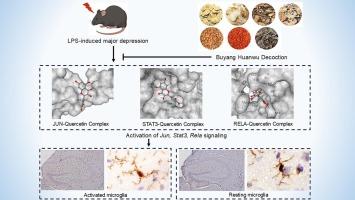Network pharmacology combined with experimental verification for exploring the potential antidepressant mechanism of Traditional Chinese Medicine Buyang Huanwu Decoction in lipopolysaccharide-induced depressed mouse model
IF 2.6
4区 医学
Q3 NEUROSCIENCES
引用次数: 0
Abstract
Background
Major depression (MDD) is a psychophysiological disorder that places heavy burden on human society. The Buyang Huanwu Decoction (BHD) can delay the pathological progression of MDD; however, its pharmacological mechanism remains unclear. This study aims to investigate the anti- antidepressant mechanism of BHD.
Methods
This study identifies BHD targets and depression-related targets. Cross analysis reveals BHD’s potential antidepressant targets. A protein–protein interaction network is constructed and functionally enriched. Molecular docking focuses on the top six hub targets and their active compounds. Network pharmacology predictions are validated in lipopolysaccharide (LPS)-induced depressed mice after treatment with BHD, combined with behavioral tests, RT-qPCR, immunohistochemistry, and biological safety by alanine aminotransferase (ALT), aspartate aminotransferase (AST), and blood urea nitrogen (BUN) assays.
Results
We obtain 306 candidate targets for BHD to alleviate MDD, and analyze their biological functions in the study. KEGG enrichment illustrates that the lipid and atherosclerosis and PI3K-Akt signaling pathways are important. Then we obtain four core targets, including JUN, STAT3, TP53, and RELA. These results are validated by random forest analysis and molecular docking. BHD alleviates anxiety-depression-like behaviors in LPS-induced mice, reduces hippocampal Jun, Stat3, and Rela mRNA levels and suppresses microglial activation and pro-inflammatory cytokine release.
Conclusion
This study suggests that BHD effectively ameliorates LPS-induced anxiety- and depression-like behavior, likely by suppressing the Jun, Stat3, and Rela signaling to regulate neuroinflammation in hippocampus. This work offers novel insights into the mechanisms underlying herbal formulas as natural preventive intervention for MDD.

网络药理学结合实验验证,探讨补阳还五汤对脂多糖诱导抑郁小鼠模型的潜在抗抑郁机制。
背景:重度抑郁症(MDD)是一种给人类社会带来沉重负担的心理生理障碍。补阳还五汤能延缓重度抑郁症的病理进展;然而,其药理机制尚不清楚。本研究旨在探讨重度抑郁症的抗抑郁机制。方法:本研究确定了7个BHD靶点和抑郁相关靶点。交叉分析揭示了BHD潜在的抗抑郁药物靶点。蛋白质-蛋白质相互作用网络被构建并功能丰富。分子对接的重点是前5个枢纽靶点及其活性化合物。网络药理学预测在BHD治疗后脂多糖(LPS)诱导的抑郁小鼠中得到验证,并结合行为测试、RT-qPCR、免疫组织化学以及丙氨酸转氨酶(ALT)、天冬氨酸转氨酶(AST)和血尿素氮(BUN)测定的生物安全性。结果:获得306个BHD缓解MDD候选靶点,并分析其生物学功能。KEGG的富集说明脂质和动脉粥样硬化以及PI3K-Akt信号通路是重要的。然后我们获得了四个核心靶点,包括JUN, STAT3, TP53和RELA。这些结果通过随机森林分析和分子对接得到了验证。BHD减轻lps诱导小鼠的焦虑抑郁样行为,降低海马Jun、Stat3和Rela mRNA水平,抑制小胶质细胞激活和促炎细胞因子释放。结论:本研究提示BHD有效改善lps诱导的焦虑和抑郁样行为,可能是通过抑制Jun、Stat3和Rela信号来调节海马神经炎症。这项工作为草药配方作为MDD的自然预防干预的机制提供了新的见解。
本文章由计算机程序翻译,如有差异,请以英文原文为准。
求助全文
约1分钟内获得全文
求助全文
来源期刊

Brain Research
医学-神经科学
CiteScore
5.90
自引率
3.40%
发文量
268
审稿时长
47 days
期刊介绍:
An international multidisciplinary journal devoted to fundamental research in the brain sciences.
Brain Research publishes papers reporting interdisciplinary investigations of nervous system structure and function that are of general interest to the international community of neuroscientists. As is evident from the journals name, its scope is broad, ranging from cellular and molecular studies through systems neuroscience, cognition and disease. Invited reviews are also published; suggestions for and inquiries about potential reviews are welcomed.
With the appearance of the final issue of the 2011 subscription, Vol. 67/1-2 (24 June 2011), Brain Research Reviews has ceased publication as a distinct journal separate from Brain Research. Review articles accepted for Brain Research are now published in that journal.
 求助内容:
求助内容: 应助结果提醒方式:
应助结果提醒方式:


